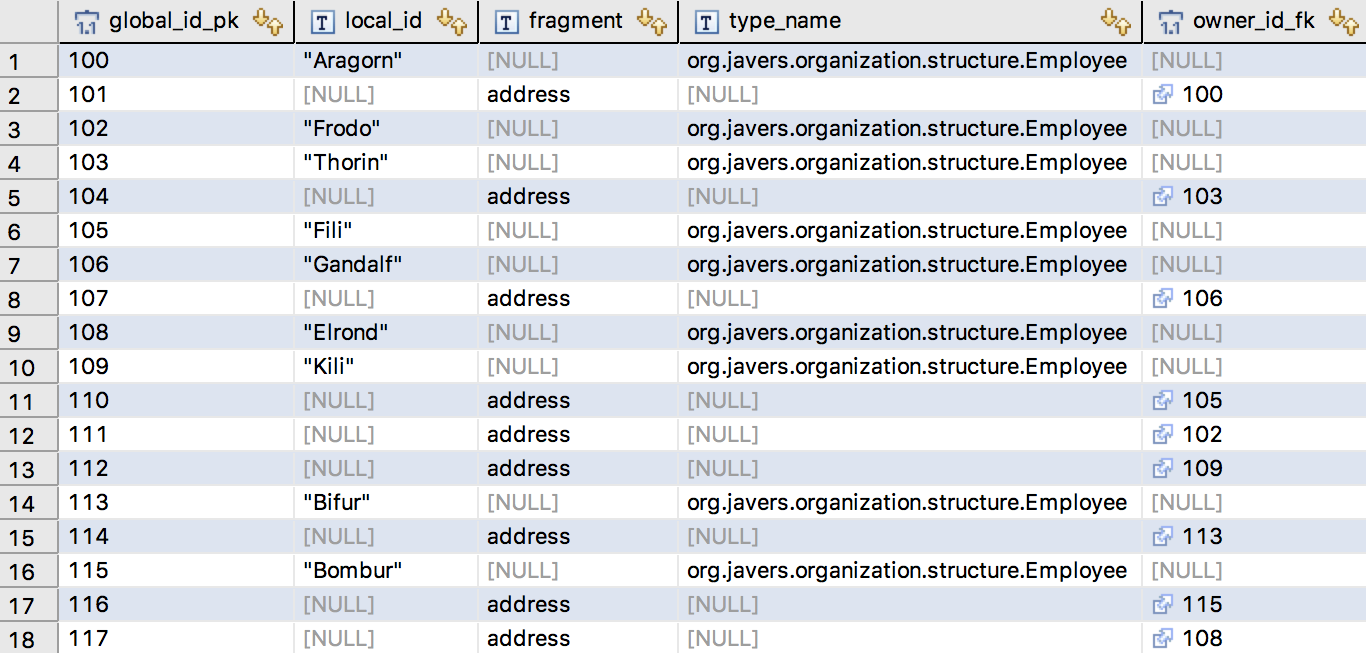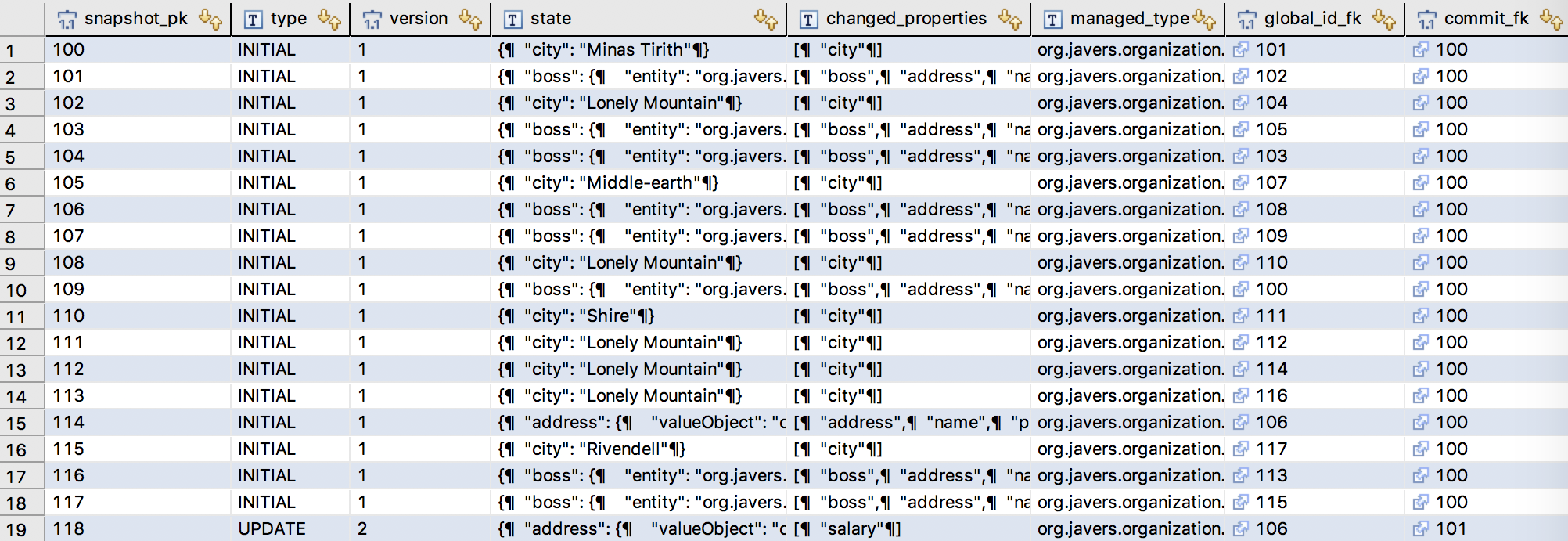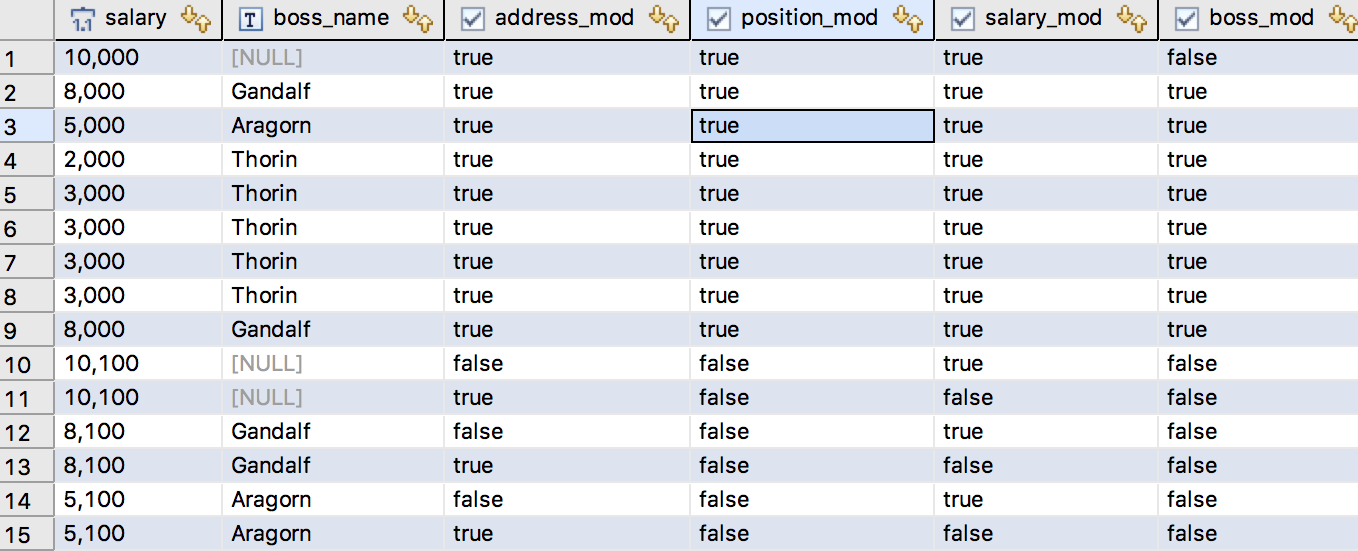In the Java world, there are two tools for data auditing: Envers and JaVers. Envers is here for a long time and it’s considered mainstream. JaVers offers the fresh approach and technology independence. If you consider which tool will be better for your project, this article is the good starting point.
The article has three sections. First, is a high-level comparison. In the second section, I show the simple, demo application for managing organization structure with data audit made by both JaVers and Envers. In the third section, I check how both tools are coping with queries on audit data.

ToC
High-level comparison
There are two big differences between JaVers and Envers:
-
Envers is the Hibernate plugin. It has good integration with Hibernate but you can use it only with traditional SQL databases. If you chose NoSQL database or SQL but with another persistence framework (for example JOOQ) — Envers is not an option.
On the contrary, JaVers can be used with any kind of database and any kind of persistence framework. For now, JaVers comes with repository implementations for MongoDB and popular SQL databases. Other databases (like Cassandra, Elastic) might be added in the future.
-
Envers’ audit model is table-oriented. You can think about Envers as the tool for versioning database records.
As the doc says: For each audited entity, an audit table is created. By default, the audit table name is created by adding a_AUDsuffix to the original name. It can be an advantage, you have audit data stored close to your live data. Envers’ tables look familiar. It’s easy to query them with SQL.JaVers’ audit model is object-oriented. It’s all about objects’ Snapshots. JaVers saves them to the single table (or the collection in Mongo) as JSON documents with unified structure. Advantages? You can focus on domain objects and treat persistence and auditing as infrastructural aspects. Since audit data are decoupled from live data, you can choose where to store them. By default, JaVers saves Snapshots to the application’s database, but you can point another one. For example, SQL for application and MongoDB for JaVers (or even centralized JaVers database shared for all applications in your company).
Demo application
Our demo project is the simple Groovy application based on Spring Boot. Clone it from https://github.com/javers/javers-vs-envers.
Let’s start with the domain model. There are only two classes: Employee and Address. Employees are organized in a tree structure.
Employee.groovy
@Entity
class Employee {
@Id
String name
@ManyToOne
Employee boss
@OneToMany(cascade = CascadeType.ALL, mappedBy = "boss")
Set<Employee> subordinates = new HashSet()
@Embedded
Address address
Integer salary
Position position
Employee() {
}
...
}
Address.groovy
@Embeddable
class Address {
@Column(name = "address_city")
String city
@Column(name = "address_street")
String street
Address() {
}
Address(String city) {
this.city = city
}
}
Database configuration
The application is configured to work with a local PostgreSQL. You can change it easily (don’t forget about a proper JDBC driver).
application.properties
spring.datasource.url=jdbc:postgresql://localhost:5432/javers-vs-envers
build.gradle
compile 'postgresql:postgresql:9.1-901-1.jdbc4'
To run the application and populate the database, execute the
InitHierarchyTest.groovy test:
def "should init and persist organization structure"(){
given:
def boss = hierarchyService.initStructure()
boss.prettyPrint()
expect:
boss.name == "Gandalf"
}
You can run it from command line:
./gradlew test --tests InitHierarchyTest
Now you should have the Employee table populated with initial data.
select * from Employee
Enabling Envers audit
To enable Envers we need to add the hibernate-envers dependency:
compile 'org.hibernate:hibernate-envers:'+hibernateVersion
and @Audited annotation to our entity:
import org.hibernate.envers.Audited
@Entity
@Audited
class Employee {
...
}
That’s it. Now, we can do some audited changes:
SimpleChangeTest.groovy
def "should persist Employee's property change"(){
given:
def boss = hierarchyService.initStructure()
hierarchyService.giveRaise(boss, 200)
expect:
hierarchyService.findByName("Gandalf").salary == 10200
}
Envers creates two tables: revinfo and employee_aud.
select * from revinfo

select * from employee_aud
No surprise so far. We have two revisions linked with records in the audit table. Revtype 0 means insert and 1 means update. What is strange is the type of revision timestamps. Why long instead of date? Luckily you can fix using custom Revision Entity. Also, Revision Entity is the place when you can hook revision metadata like change author.
Enabling JaVers audit
To enable JaVers we need to add this dependency to JaVers Spring Boot starter for SQL:
compile 'org.javers:javers-spring-boot-starter-sql:7.9.0'
The easiest way to integrate JaVers with a Spring application is the
@JaversSpringDataAuditable annotation added to Spring Data CRUD repositories.
This annotation enables the auto-audit aspect.
EmployeeRepository.groovy
import org.javers.spring.annotation.JaversSpringDataAuditable
import org.springframework.data.repository.CrudRepository
@JaversSpringDataAuditable
interface EmployeeRepository extends CrudRepository<Employee, String> {
}
That’s all. Now, when you rerun the SimpleChangeTest,
JaVers will create three tables:
jv_commit,jv_global_id,jv_snapshot
(there is also the fourth table — jv_commit_property, but our application doesn’t touch it).
JaVers’ Commit is the similar concept to Envers’ revision (inspirations from Git and Subversion are evident). Each Commit has timestamp and author. Here, author field is unknown, it would be set to current user if you enable Spring Security (see AuthorProvider).
select * from jv_commit
Now, let’s check out how objects’ Snapshots are stored.
In JaVers, each audited object has GlobalId.
For Entities, it’s the pair of type name and local Id.
ValueObjects (like Address) are treated as components of an Entity,
so they are identified by the pair: owning entity GlobalId and a path (typically a property name).
We have 18 objects so far, hence 18 GlobalIds are stored.
select * from jv_global_id
For each GlobalId, JaVers creates one or more object’s Snapshots. We did only one change so far (Gandalf got a rise), so we have 18 initial Snapshots and one update Snapshot for Gandalf. Seems right.
select * from jv_snapshot
What distinguishes JaVers from Envers is the state column, here live Snapshots per se.
It’s the text column with JSON documents.
Thanks to that, JaVers isn’t coupled to any particular kind of database.
As long as a database supports text or JSON types, it’s fine.
In fact, MongoDB is more natural to JaVers than SQL,
because MongoDB is designed to store JSON documents.
The Snapshot state document is the map where keys are property names and values are, well, property values (pretty much like in Javascript). References to other objects are dehydrated and stored as GlobalId.
For example, this is the current state of Gandalf:
{
"address": {
"valueObject": "org.javers.organization.structure.Address",
"ownerId": {
"entity": "org.javers.organization.structure.Employee",
"cdoId": "Gandalf"
},
"fragment": "address"
},
"name": "Gandalf",
"position": "CEO",
"salary": 10200,
"subordinates": [
{
"entity": "org.javers.organization.structure.Employee",
"cdoId": "Elrond"
},
{
"entity": "org.javers.organization.structure.Employee",
"cdoId": "Aragorn"
}
]
}
Querying contest
Some applications have data audit implemented only just in case. For example, in case of an unexpected and intimidating visit of an IT auditor asking you questions. In this scenario, an application doesn’t need to have any special UI for browsing audit data. Any developer can connect directly to a database, generate some reports and make auditor happy.
In other applications, data audit is so important that it becomes one of the features offered to users. For example, Wikipedia has the page history view which shows changes made to any page.
I’ve focused on the second case, our demo application runs queries against audit data to show history of The Fellowship.
Browsing objects history by type
Let’s start with the elementary query — query by type. We are giving a rise for Gandalf and Aragorn and also we are changing their address. That means four changes.
given:
def gandalf = hierarchyService.initStructure()
def aragorn = gandalf.getSubordinate('Aragorn')
gandalf.prettyPrint()
//changes
hierarchyService.giveRaise(gandalf, 200)
hierarchyService.updateCity(gandalf, 'Shire')
hierarchyService.giveRaise(aragorn, 100)
hierarchyService.updateCity(aragorn, 'Shire')
Then we want to browse history of our Employees in Envers and JaVers.
Envers way
@Transactional
def "should browse Envers history of objects by type"(){
given:
...
when:
List folks = AuditReaderFactory
.get(entityManager)
.createQuery()
.forRevisionsOfEntity( Employee, false, true )
.add(AuditEntity.revisionType().eq(MOD)) // without initial versions
.getResultList()
println 'envers history of Employees:'
folks.each {
println 'revision:' + it[1].id + ', entity: '+ it[0]
}
then:
folks.size() == 4
}
Envers output:
envers history of Employees:
revision:33, entity: Employee{ Gandalf CEO, $10200, Middle-earth, subordinates:Aragorn,Elrond }
revision:34, entity: Employee{ Gandalf CEO, $10200, Shire, subordinates:Aragorn,Elrond }
revision:35, entity: Employee{ Aragorn CTO, $8100, Minas Tirith, subordinates:Thorin }
revision:36, entity: Employee{ Aragorn CTO, $8100, Shire, subordinates:Thorin }
JaVers way
def "should browse JaVers history of objects by type"(){
given:
...
when:
List<Shadow<Employee>> shadows = javers.findShadows(
QueryBuilder.byClass(Employee)
.withSnapshotTypeUpdate()
.build())
println 'javers history of Employees:'
shadows.each { shadow ->
println 'commit:' + shadow.commitMetadata.id + ', entity: '+ shadow.get()
}
then:
shadows.size() == 4
shadows[0].commitMetadata.id.majorId == 5
shadows[3].commitMetadata.id.majorId == 2
}
JaVers output:
javers history of Employees:
commit:5.0, entity: Employee{ Aragorn CTO, $8100, Shire, subordinates:Thorin }
commit:4.0, entity: Employee{ Aragorn CTO, $8100, Minas Tirith, subordinates:Thorin }
commit:3.0, entity: Employee{ Gandalf CEO, $10200, Shire, subordinates:Aragorn,Elrond }
commit:2.0, entity: Employee{ Gandalf CEO, $10200, Middle-earth, subordinates:Aragorn,Elrond }
Comparision
Both tools have done the job and shown correct history. Both tools have loaded related entities.
What about artistic impression? There are a few interesting differences.
-
Envers query results are ordered chronologically. The oldest change is first on the list. When browsing history, usually you want to see latest changes first. The reverse chronological order is more natural and that’s how JaVers sorts. I didn’t find the way in Envers to get reverse ordering.
-
JaVers query API seems more elegant. It’s called JQL (JaVers Query Language).
-
What is really cryptic in Envers’ query is the results type. Why
getResultList()returns non-parametrized List? List of what? Well, it depends on the second flag passed toforRevisionsOfEntity()namedselectEntitiesOnly. If it’s true, it will be a list of entities, otherwise — a list of three-element arrays, containing: the entity instance, revision entity, and type of the revision. Not cool. In Groovy it’s not a problem but in Java you have to cast heavily to get the data. In JaVers, you get the type-safe list of Shadows. In short, Shadow is a pair of a historical entity and commit metadata. -
Both tools have loaded related entities (subordinates and boss), although we didn’t ask for this. Envers uses well-known Hibernate lazy loading approach. On the contrary, JaVers always loads data eagerly on a basis of the query scope. Both approaches have pros and cons. Lazy loading looks invitingly, you get as much data as you need without bothering about underlying database queries. Disadvantages?
LazyInitializationExceptionis the constant threat. Moreover, Hibernate dynamic proxies and persistent collections clutter your object graph.
Query filters
Browsing objects history is not very useful without search filters.
In the next example we show how to implement the two common search use cases:
- Search by Id, to show history of a specified Employee.
- Search by changed property, to show history of salary changes in the whole organization.
Envers way
@Transactional
def "should browse Envers history of objects by type with filters"(){
given:
def gandalf = hierarchyService.initStructure()
def aragorn = gandalf.getSubordinate('Aragorn')
def thorin = aragorn.getSubordinate('Thorin')
//changes
[gandalf, aragorn, thorin].each {
hierarchyService.giveRaise(it, 100)
hierarchyService.updateCity(it, 'Shire')
}
when: 'query with Id filter'
List aragorns = AuditReaderFactory
.get(entityManager)
.createQuery()
.forRevisionsOfEntity( Employee, false, true )
.add(AuditEntity.id().eq( 'Aragorn' ))
.getResultList()
then:
println 'envers history of Aragorn:'
aragorns.each {
println 'revision:' + it[1].id + ', entity: '+ it[0]
}
aragorns.size() == 3
when: 'query with Property filter'
List folks = AuditReaderFactory
.get(entityManager)
.createQuery()
.forRevisionsOfEntity( Employee, false, true )
.add(AuditEntity.property('salary').hasChanged())
.add(AuditEntity.revisionType().eq(MOD))
.getResultList()
then:
println 'envers history of salary changes:'
folks.each {
println 'revision:' + it[1].id + ', entity: '+ it[0]
}
folks.size() == 3
}
Our queries didn’t change much. To search by Id we use:
.add(AuditEntity.id().eq( 'Aragorn' ))
and to search by changed property we added:
.add(AuditEntity.property('salary').hasChanged())
Looks fine, but what happens when you run this test? Whoops! The second query throws an exception:
org.hibernate.QueryException: could not resolve property: salary_MOD of: org.javers.organization.structure.Employee_AUD [select e__, r from org.javers.organization.structure.Employee_AUD e__, org.hibernate.envers.DefaultRevisionEntity r where e__.salary_MOD = :_p0 and e__.REVTYPE = :_p1 and e__.originalId.REV.id = r.id order by e__.originalId.REV.id asc]
Looks like there is a missing column —
salary_MOD in the employee_AUD table. But this table is managed by Envers,
why he can’t find a column in his own table?
After some digging in the User Guide, we can find the answer — Modification Flags. If we want to query by changed property we need to enable them for our class:
@Entity
@Audited( withModifiedFlag=true )
class Employee {
...
Then, Envers adds the boolean matrix to the employee_AUD table:
When we see these flags, they become obvious. Envers uses them to find records with changes on a given property.
Now, the Envers output seems right:
envers history of Aragorn:
revision:6554, entity: Employee{ Aragorn CTO, $8000, Minas Tirith, subordinates:'Thorin' }
revision:6557, entity: Employee{ Aragorn CTO, $8100, Minas Tirith, subordinates:'Thorin' }
revision:6558, entity: Employee{ Aragorn CTO, $8100, Shire, subordinates:'Thorin' }
envers history of salary changes:
revision:6555, entity: Employee{ Gandalf CEO, $10100, Middle-earth, subordinates:'Aragorn','Elrond' }
revision:6557, entity: Employee{ Aragorn CTO, $8100, Minas Tirith, subordinates:'Thorin' }
revision:6559, entity: Employee{ Thorin TEAM_LEAD, $5100, Lonely Mountain, subordinates:'Bombur','Frodo','Fili','Kili','Bifur' }
On the contrary, JaVers queries works out of the box.
JaVers way
def "should browse JaVers history of objects by type with filters"(){
given:
def gandalf = hierarchyService.initStructure()
def aragorn = gandalf.getSubordinate('Aragorn')
def thorin = aragorn.getSubordinate('Thorin')
//changes
[gandalf, aragorn, thorin].each {
hierarchyService.giveRaise(it, 100)
hierarchyService.updateCity(it, 'Shire')
}
when: 'query with Id filter'
List<Shadow<Employee>> shadows = javers.findShadows(
QueryBuilder.byInstanceId('Aragorn', Employee).build())
then:
println 'javers history of Aragorn:'
shadows.each { shadow ->
println 'commit:' + shadow.commitMetadata.id + ', entity: '+ shadow.get()
}
shadows.size() == 3
when: 'query with Property filter'
shadows = javers.findShadows(
QueryBuilder.byClass(Employee)
.withChangedProperty('salary')
.withSnapshotTypeUpdate()
.build())
then:
println 'javers history of salary changes:'
shadows.each { shadow ->
println 'commit:' + shadow.commitMetadata.id + ', entity: '+ shadow.get()
}
shadows.size() == 3
}
JaVers output:
javers history of Aragorn:
commit:5.1, entity: Employee{ Aragorn CTO, $8100, Shire, subordinates: }
commit:4.1, entity: Employee{ Aragorn CTO, $8100, Minas Tirith, subordinates: }
commit:1.1, entity: Employee{ Aragorn CTO, $8000, Minas Tirith, subordinates: }
javers history of salary changes:
commit:6.0, entity: Employee{ Thorin TEAM_LEAD, $5100, Lonely Mountain, subordinates: }
commit:4.1, entity: Employee{ Aragorn CTO, $8100, Minas Tirith, subordinates: }
commit:2.1, entity: Employee{ Gandalf CEO, $10100, Middle-earth, subordinates: }
Comparision
Once again both tools have done the job and shown correct history.
-
Search by Id. Just works as expected.
-
Search by changed property. Here, at the beginning, Envers threw an exception and we had to add the Modification Flags to the table schema. I like the design of these flags for its simplicity. The problem is that they are disabled by default.
What if your application is running on production for some time and you didn’t enable the Flags from the very beginning? Adding them to existing tables could be a pain…
I think that JaVers solved this problem in a bit more elegant way. By default, each Snapshot holds the list of changed property names (injv_snapshot.changed_properties). Snapshot structure is fixed, no more mucking around flags configuration.
More query filters
What are the other options for filtering? Envers offers filtering by property value:
query.add(AuditEntity.property("name").eq("John"));
// or
query.add(AuditEntity.relatedId("address").eq(addressId));
This is useful. Besides eq, you can use many other operators typical to SQL: ge, le, like, between, etc.
In JaVers, there are no property value filters, we have the open issue for that. On the other hand, JaVers offers a few filters based on Commit metadata. You can query by Commit author, dates and properties:
QueryBuilder.byInstanceId("bob", Employee.class).byAuthor("Pam").build()
// or
QueryBuilder.byInstanceId("bob", Employee.class).withCommitProperty("tenant", "ACME")
// or
QueryBuilder.byInstanceId("bob", Employee.class)
.from(new LocalDate(2016,01,1))
.to (new LocalDate(2018,01,1)).build()
See the full list of JaVers’ query filters.
Reconstructing full object graphs
The last task is the hardest part of the competition. We want to reconstruct the full object graph for a given point in time. That means time-aware joins which are tricky.
In this use case, we load the historical version of one Employee and we check if related Employees are joined in proper versions.
To make the case harder (and more realistic), we update Employees independently. What we want from JaVers and Envers is recalling that specific point in time when all the guys had the same salary — $6000.
given:
def gandalf = hierarchyService.initStructure()
def aragorn = gandalf.getSubordinate('Aragorn')
def thorin = aragorn.getSubordinate('Thorin')
def bombur = thorin.getSubordinate("Bombur")
[gandalf,aragorn, bombur].each {
hierarchyService.updateSalary(it, 6000)
}
hierarchyService.giveRaise(thorin, 1000)
//this state we want to reconstruct,
//when all the four guys have salary $6000
gandalf.prettyPrint()
[gandalf, aragorn, thorin, bombur].each {
hierarchyService.giveRaise(it, 500)
}
Let’s start the challenge from Envers.
Envers way
@Transactional
def "should reconstruct a full object graph with Envers"(){
given:
...
when:
def start = System.currentTimeMillis()
List thorins = AuditReaderFactory
.get(entityManager)
.createQuery()
.forRevisionsOfEntity( Employee, false, true )
.add( AuditEntity.id().eq( 'Thorin' ) )
.getResultList()
then:
def thorinShadow = thorins.collect{it[0]}.find{it.salary == 6000}
[thorinShadow,
thorinShadow.getBoss(),
thorinShadow.getBoss().getBoss(),
thorinShadow.getSubordinate("Bombur")].each
{
println it
assert it.salary == 6000
}
println "Envers query executed in " + (System.currentTimeMillis() - start) + " millis"
}
Envers output:
Employee{ Thorin TEAM_LEAD, $6000, Lonely Mountain, subordinates:'Bombur','Frodo','Fili','Kili','Bifur' }
Employee{ Aragorn CTO, $6000, Minas Tirith, subordinates:'Thorin' }
Employee{ Gandalf CEO, $6000, Middle-earth, subordinates:'Aragorn','Elrond' }
Employee{ Bombur SCRUM_MASTER, $6000, Lonely Mountain, subordinates: }
Envers query executed in 47 millis
JaVers way
def "should reconstruct a full object graph with JaVers"(){
given:
...
when:
def start = System.currentTimeMillis()
List<Shadow<Employee>> shadows = javers.findShadows(
QueryBuilder.byInstanceId('Thorin', Employee)
.withScopeDeepPlus()
.build())
then:
def thorinShadow = shadows.collect{it.get()}.find{it.salary == 6000}
[thorinShadow,
thorinShadow.getBoss(),
thorinShadow.getBoss().getBoss(),
thorinShadow.getSubordinate("Bombur")].each
{
println it
assert it.salary == 6000
}
println "JaVers query executed in " + (System.currentTimeMillis() - start) + " millis"
}
JaVers output:
Employee{ Thorin TEAM_LEAD, $6000, Lonely Mountain, subordinates:'Bombur','Frodo','Fili','Kili','Bifur' }
Employee{ Aragorn CTO, $6000, Minas Tirith, subordinates:'Thorin' }
Employee{ Gandalf CEO, $6000, Middle-earth, subordinates:'Aragorn','Elrond' }
Employee{ Bombur SCRUM_MASTER, $6000, Lonely Mountain, subordinates: }
JaVers query executed in 48 millis
Comparision
Both tools have succeeded to reconstruct the correct object graph.
Thorin’s version is wired with
the right Aragorn’s version, which is wired with the right
Gandalf’s version.
Believe or not, this reconstruction is not trivial
because it’s implemented atop of an ordinary SQL database which is unaware of time dimensions.
Performance benchmark is beyond the scope of this article. When you try to reconstruct large object graphs on a production database, you are likely to face performance issues both in JaVers and Envers.
In JaVers you can enable a simple profiler tool, which logs query execution statistics
to standard slf4j logger:
<logger name="org.javers.JQL" level="DEBUG"/>
Then, you can analyze logs from the JQL query execution:
[main] org.javers.core.Javers : Commit(id:6.1, snapshots:1, author:unknown, changes - ValueChange:1), done in 68 millis (diff:64, persist:4)
[main] org.javers.core.Javers : Commit(id:7.1, snapshots:1, author:unknown, changes - ValueChange:1), done in 54 millis (diff:52, persist:2)
[main] org.javers.core.Javers : Commit(id:8.0, snapshots:1, author:unknown, changes - ValueChange:1), done in 66 millis (diff:64, persist:2)
[main] org.javers.core.Javers : Commit(id:9.0, snapshots:1, author:unknown, changes - ValueChange:1), done in 62 millis (diff:57, persist:5)
[main] org.javers.JQL : SHALLOW query: 4 snapshots loaded (entities: 3, valueObjects: 1)
[main] org.javers.JQL : DEEP_PLUS query for '...Employee/Aragorn' at commitId 8.0, 4 snapshot(s) loaded, gaps filled so far: 1
[main] org.javers.JQL : DEEP_PLUS query for '...Employee/Gandalf' at commitId 8.0, 4 snapshot(s) loaded, gaps filled so far: 2
[main] org.javers.JQL : DEEP_PLUS query for '...Employee/Elrond' at commitId 8.0, 2 snapshot(s) loaded, gaps filled so far: 3
[main] org.javers.JQL : DEEP_PLUS query for '...Employee/Frodo' at commitId 8.0, 2 snapshot(s) loaded, gaps filled so far: 4
[main] org.javers.JQL : DEEP_PLUS query for '...Employee/Kili' at commitId 8.0, 2 snapshot(s) loaded, gaps filled so far: 5
[main] org.javers.JQL : DEEP_PLUS query for '...Employee/Fili' at commitId 8.0, 2 snapshot(s) loaded, gaps filled so far: 6
[main] org.javers.JQL : DEEP_PLUS query for '...Employee/Bifur' at commitId 8.0, 2 snapshot(s) loaded, gaps filled so far: 7
[main] org.javers.JQL : DEEP_PLUS query for '...Employee/Bombur' at commitId 8.0, 3 snapshot(s) loaded, gaps filled so far: 8
[main] org.javers.JQL : queryForShadows executed:
JqlQuery {
IdFilter{ globalId: ...Employee/Thorin }
QueryParams{ aggregate: true, limit: 100 }
ShadowScopeDefinition{ shadowScope: DEEP_PLUS, maxGapsToFill: 10 }
Stats{
executed in millis: 36
DB queries: 9
all snapshots: 25
SHALLOW snapshots: 4
DEEP_PLUS snapshots: 21
gaps filled: 8
}
}
The rule of thumb — try to keep the number of DB queries executed per each JQL query as small as possible. Use the right Shadow scope (read more about scopes).
Other query types
Envers has the only one type of query result — historical versions of an object, which is the most natural view of objects history.
In JaVers, this query type is called Shadow query (that’s why we use findShadows() in query examples).
Besides that, JaVers provides two more query types:
Snapshots query
and
Changes query.
Snapshots contain the same data as Shadows, but they are dehydrated. What does it mean?
- Snapshot is an instance of the JaVers’
CdoSnapshotclass, while Shadow is simply an instance of a user’s domain class. - Snapshot is self-contained and can be easily serialized/deserialized to JSON and send over network. Snapshots can be useful for example when you are building REST API for a frontend application (see how we use Snapshots in the POC of JaVers GUI).
Changes are the best choice for rendering objects history as a unified change log.
JaVers provides the SimpleTextChangeLog formatter, which creates the textual changelog like this:
commit 3.0, author: hr.manager, 2015-04-16 22:16:50
changed object: Employee/Bob
list changed on 'subordinates' property: [(0).added:'Employee/Trainee One', (1).added:'Employee/Trainee Two']
commit 2.0, author: hr.director, 2015-04-16 22:16:50
changed object: Employee/Bob
value changed on 'position' property: 'Scrum master' -> 'Team Lead'
value changed on 'salary' property: '9000' -> '11000'
It’s easy to implement your own change log formatter (see example).
Final thoughts
So which tool is better?
As the author of JaVers I can’t be objective when answering this question (you can easily guess what is my opinion). In fact, the goal of this article is to provide a fair comparison of JaVers and Envers which give you enough information to make a conscious decision.






